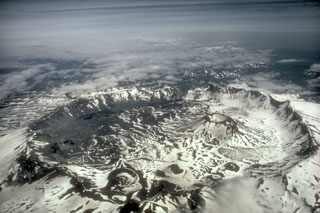Report on Aniakchak (United States) — 12 April-18 April 2023
Smithsonian Institution / US Geological Survey
Weekly Volcanic Activity Report, 12 April-18 April 2023
Managing Editor: Sally Sennert.
Please cite this report as:
Global Volcanism Program, 2023. Report on Aniakchak (United States) (Sennert, S, ed.). Weekly Volcanic Activity Report, 12 April-18 April 2023. Smithsonian Institution and US Geological Survey.
Aniakchak
United States
56.88°N, 158.17°W; summit elev. 1341 m
All times are local (unless otherwise noted)
On 13 April AVO issued an Information Statement about the ongoing unrest at Aniakchak. Measurements of the earthquake rate in the ongoing swarm were disrupted by a partial network outage that began on 4 March and reduced the ability to detect smaller earthquakes. Earthquake activity continued to be above background levels with a M 3.3 on 6 April as the largest recent event. In addition to the earthquake swarm, high rates of deformation were detected in radar data. A zone of uplift centered within the W side of the caldera was first detected between 4 and 27 February. The ground uplift rates were about 4 cm per week during February-March and about 3 cm per week during 23 March-4 April. These uplift rates are at the high end of those observed for restless volcanoes worldwide.
Seismic and deformation data suggested that magma was intruding beneath the caldera at a depth of 3-4 km below sea level. AVO noted that unrest at calderas such as Aniakchak sometimes lasts for many months or even years and could be variable . If an eruption were to occur, it could be after a period of months or years and would likely be preceded by additional signals that would allow AVO to provide advance warning. Aniakchak has a local monitoring network consisting of six seismometers, a web camera, and an infrasound sensor, as well as with satellite remote sensing data and regional infrasound and lightning networks. AVO recently installed an additional seismic station and web camera in Port Heiden, 26 km NW. The Aviation Color Code remained at Yellow (the second lowest level on a four-color scale) and the Volcano Alert Level remained at Advisory (the second lowest level on a four-level scale).
Geological Summary. One of the most dramatic calderas of the Aleutian arc, the 10-km-wide Aniakchak caldera formed around 3,400 years ago during a voluminous eruption in which pyroclastic flows traveled more than 50 km N to the Bering Sea and also reached the Pacific Ocean to the south. At least 40 explosive eruptions have been documented during the past 10,000 years, making it the most active volcano of the eastern Aleutian arc. A dominantly andesitic pre-caldera volcano was constructed above basement Mesozoic and Tertiary sedimentary rocks that are exposed in the caldera walls to elevations of about 610 m. The ice-free caldera floor contains many pyroclastic cones, tuff cones, maars, and lava domes. Surprise Lake on the NE side drains through The Gates, a steep-walled breach on the east side of the 1-km-high caldera rim that was the site of catastrophic draining of a once larger lake about 1850 years BP. Vent Mountain and Half Cone are two long-lived vents on the south-central and NW caldera floor, respectively. The first and only confirmed historical eruption took place in 1931 from vents on the west and SW caldera floor.
Source: US Geological Survey Alaska Volcano Observatory (AVO)

